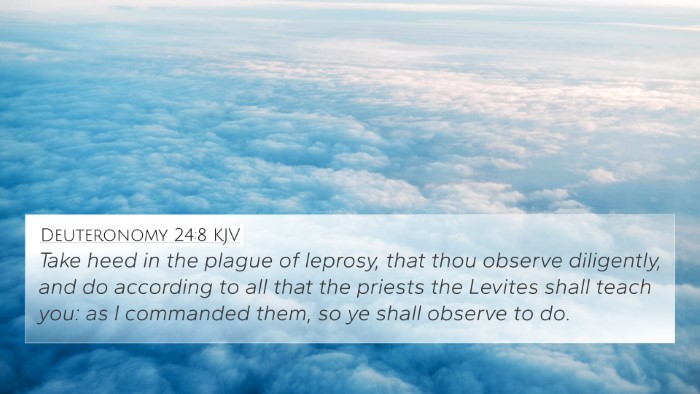Understanding Leviticus 13:2
Leviticus 13:2 states: "When a man shall have in the skin of his flesh a rising, a scab, or a bright spot, and it be in the skin of his flesh like the plague of leprosy; then he shall be brought unto Aaron the priest, or unto one of his sons the priests."
Summary of Meaning
This verse introduces the regulations concerning the identification of leprosy, a serious and often misunderstood condition in ancient Israel. It emphasizes the need for proper examination by the priests, demonstrating both the seriousness with which such ailments were treated and the role of the priesthood in matters of health and purity.
Commentary Insights
Matthew Henry's Commentary:
Henry highlights the importance of the priest's role as a health inspector in Israel. He notes that this process underscores God's particular concern for physical and spiritual cleanliness among His people. The priest acts as an intermediary between God and the afflicted, reflecting the divine concern for the health of the community.
Albert Barnes' Notes:
Barnes elaborates on the criteria specified in this verse, stating that the symptoms require careful observation. He suggests that the term "bright spot" signifies the need for discernment in evaluating the outward signs, which could lead to a diagnosis that affects one's social standing and religious participation.
Adam Clarke's Commentary:
Clarke emphasizes the symbolic nature of leprosy in scripture, reflecting sin and its isolating impact on the sinner. He draws parallels between physical ailments like leprosy and spiritual defilement, stressing the need for regular self-examination and seeking restoration through God's prescribed means.
Bible Verse Cross-References
- Leviticus 14:2 - Discusses the cleansing process for those healed of leprosy.
- Matthew 8:2-3 - Jesus heals a leper, illustrating the fulfillment of the Law.
- Mark 1:40-42 - Similar account of Jesus healing a leper, showcasing His authority over disease.
- Luke 5:12-13 - Another instance of Jesus healing a leper, reinforcing His compassion.
- 2 Kings 5:1-14 - The story of Naaman, a leper, teaches about faith and healing.
- Numbers 12:10 - Miriam's leprous condition serves as a example of divine punishment for sin.
- Hebrews 13:12 - Connects the concept of purification through sacrifice, alluding to the sacrifices required for healing.
Thematic Connections
This verse and its context provide rich opportunities for Bible verse cross-referencing. The connections between Old and New Testament teachings illuminate themes of purity, sin, and divine interaction. The examination by a priest also highlights broader concepts of accountability and community health.
Tools for Bible Cross-Referencing
To delve deeper into the thematic Bible verse connections, consider using Bible concordance or resources designed for cross-reference Bible study. These tools aid in uncovering the intricate web of meanings and relationships within the scripture.
Identifying Cross-References
To effectively study connections between verses, a careful approach to cross-referencing Biblical texts is essential. Utilize a Bible cross-reference guide and explore the Bible reference resources available in your study materials.
Understanding Themes Through Cross-References
The act of cross-referencing Bible study methods not only enriches one's understanding of a specific verse but also facilitates a deeper appreciation of the interconnectedness of scriptural themes. For example, the healing of lepers in the Gospels echoes the laws and practices established in Leviticus.
User Intent and Cross-Referencing
For those asking what verses are related to Leviticus 13:2, the cross-references provided above are invaluable. Understanding how do two specific Bible verses connect enhances one's grasp of God's overarching narrative.
Conclusion
Leviticus 13:2 serves as an important passage in the Bible, inviting readers to consider not only the physical aspects of the law but also the deeper spiritual implications. Engaging with the text through a lens of comparative Bible verse analysis allows for a fuller appreciation of its relevance today.






















